What to do if the leaves of a rose are curled?
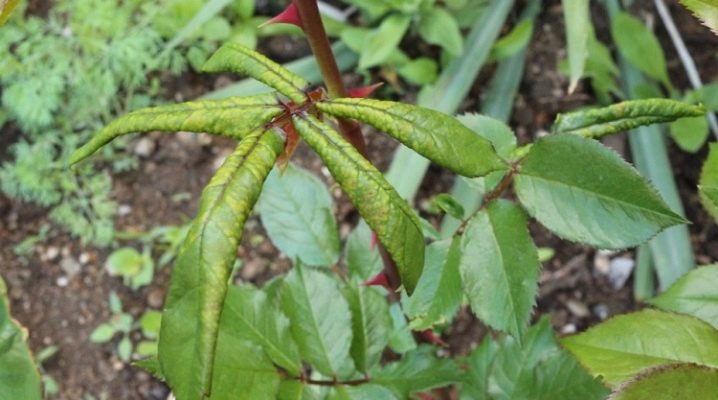
Both garden and indoor roses require quite a lot of attention. These are capricious flowers, and often gardeners have problems in growing. One of them is curling foliage. The reasons for this phenomenon, as well as methods for its elimination, will be considered in the article.


Care errors and their correction
The leaves of a rose very often curl through the fault of the gardener himself. There are several reasons for this.
- Low humidity level. This problem is especially relevant for indoor roses. In dry air, the leaves begin to wither, curl into a tube, and may even turn yellow. If the reason is precisely low humidity, it is worth increasing its performance. To do this, next to the roses, you can put a couple of plates filled with water. A humidifier will also help. In addition, the foliage of the bushes should be sprayed or wiped with a damp cloth. You can arrange a warm shower in the bathroom for indoor roses, having previously covered the soil with a package.
- Heat. Roses do not tolerate heat extremely well. In such conditions, foliage is the first to signal too high a temperature. Indoor roses need to be moved to a cooler room. Garden ones are not planted in advance where it is impossible to create at least partial shading.
- Lack or excess of light. Rose bushes love the sun, but they cannot be placed in completely open areas under the scorching active rays. At the same time, the constant shadow will be harmful to this culture. Here you will have to look for the "golden mean". Window sills with diffused lighting are suitable for indoor crops.
- Improper watering. If you constantly allow the earth around the bushes to dry out, the rose will respond by curling the foliage outward. With a lack of water, the bush will begin to shed foliage, it may not bloom. But it is also necessary to water correctly, it is unacceptable to rush to the other extreme. Irrigation is best done in the evening, you can install drip irrigation.
- Temperature changes. Rose loves coolness more and can even endure cold weather. But a sharp shift from heat to cold and vice versa is destructive for the plant.
For the same reason, rooms containing indoor roses should be ventilated carefully, avoiding air currents on the flower.
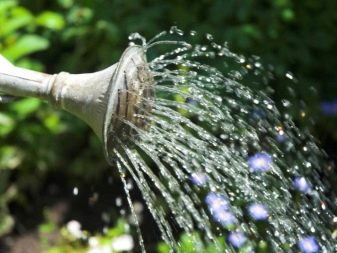
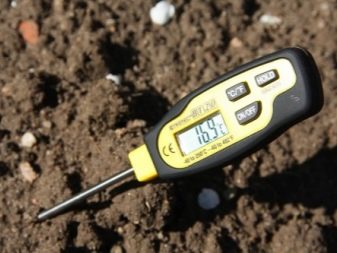
Treatment of diseases
Roses can hurt both in the room and on the street. To begin treatment, you need to be able to correctly recognize diseases that lead to curling foliage.
- Powdery mildew. This ailment affects any culture in the garden, and roses are no exception. Powdery mildew manifests itself as a white bloom on foliage, similar to cereals. A little later, it begins to darken and thicken, forms fungal spores. To prevent the whole garden from becoming infected, it is worth treating the rose with fungicidal agents, for example, "Fundazol". You can also take Bordeaux liquid. The diseased parts of the bushes are removed.
- Rust. With this disease, the leaves are covered with spots or growths of a yellowish, red color. The foliage begins to curl and then falls off. The general immunity of the bush is weakened. You can treat rust with iron vitriol, Bordeaux liquid, "Falcon".
- Black spot. In the case of this disease, purple spots begin to cover the foliage, which then become very dark. Then they increase in size, spreading over the entire leaf plate. Leaves infected with the disease are cut off and burned. The bushes are sprayed with Topaz.
In addition to fungal ailments, rose bushes can also be affected by viral diseases.They can be recognized not only by the twisting of the foliage, but also by the critical deformation of the shoots and stems. Diseased plants stop growing. Viruses are not treated, infected bushes must be removed.
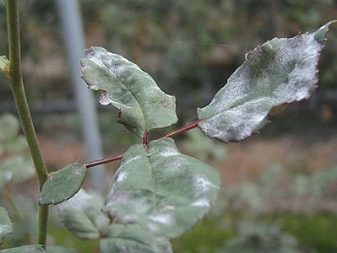
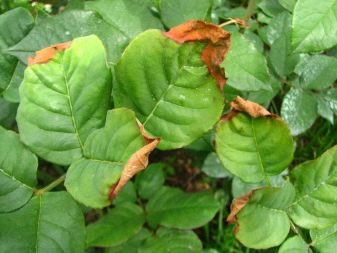
Pest control
Quite often, indoor and garden roses can attack pests. Their activity leads not only to the twisting of the leaf plates, but also to the general oppression of the plant. In addition, the pests tolerate the fungus well.
Rose aphid
This tiny insect quickly colonizes rose bushes and some other plants in the garden. Very easy to recognize as it leaves a sticky residue. Most often, aphids live on the lower part of the leaf plates, and they also make masonry there.
There are several methods to get rid of aphids.
- A small colony of insects can be washed off the foliage with a good pressure of water. The lower part of the plate is especially carefully processed. You will have to repeat the procedure several times, as eggs may remain on the leaves.
- Aphids are very fond of some useful insects. These are ladybugs, ground beetles, lacewings. They should be attracted to your site.
- Grated laundry soap will allow you to remove aphids from the site. Mix a tablespoon with a liter of water, and then walk over the plants.
- No less good results will be given by infusions of garlic, decoctions of onion peels, ash and tobacco solutions. If there are too many aphids, you can use drugs such as "Nim", "Aktara", "Fitoverm".
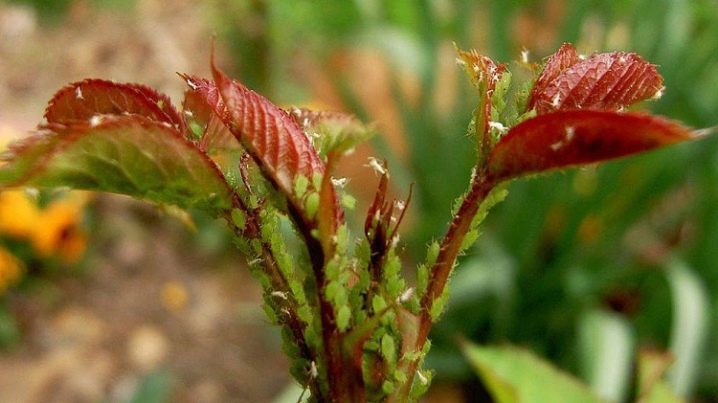
Leaf roll
These insects also very often parasitize the foliage of roses. If young leaves twisted into a tube and then fell off, you should take a closer look to see if there are any caterpillars or leafworm larvae in them.
If a pest is found, you can try the following disposal techniques.
- It is necessary to take 0.8 kg of fresh wormwood, cut, pour a bucket of water. Leave for two days, then boil. If there is not enough liquid up to 10 liters, it is necessary to add it. Then, with the resulting product, it is worth treating the bushes in the garden.
- Take 4 kg of tomato or potato tops, pour a bucket of water, leave for about 4 hours. Then strain and add 50 grams of grated soap.
- If insects are widespread, you can get rid of them with Cesar or Confidor Maxi.
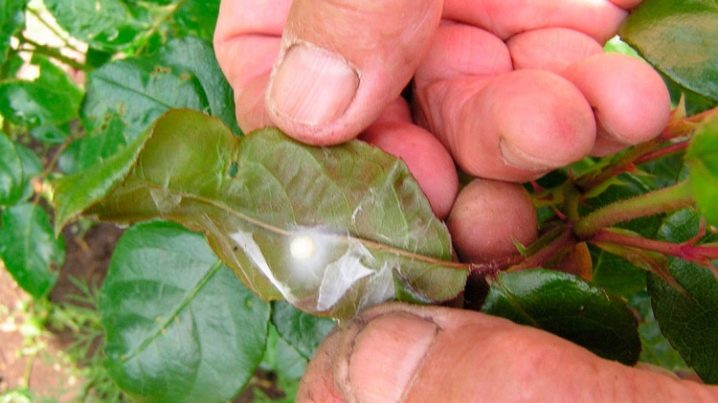
Rosacea sawfly
Sawflies are flying bugs, somewhat similar to small flies or tiny wasps. The danger is represented by their larvae, which eat young foliage and make it curl.
Let's see what to do with this type of parasite.
- Spawned sawflies can be destroyed with Aktara, Tanrek, Fitoverm and other strong insecticides.
- If there are not very many insects, you can scatter wood ash around the bushes, 500 grams per plant, and then irrigate the roses. True, the effect of the procedure cannot be called long (no more than a week).
- You need to take 1 kilogram of nightshade foliage, the raw materials must be fresh. Pour 2 liters of water, simmer for about 4 hours. Then cool and add another liter of liquid. Spray bushes and soil underneath.
These are not all pests, due to which the foliage curls inward. Also, considerable harm can be caused by spider mites, rose leafhoppers. It is better to remove the cicadocs immediately with insecticides.
With a tick, you can first try to fight with infusions of dandelions, onion husks, tobacco. If there is no result, it is worth taking acaricides ("Apollo", "Kleschevit").
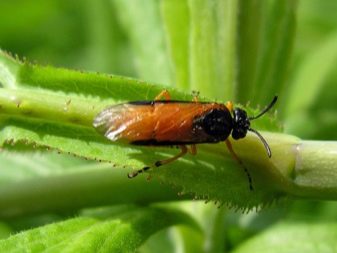
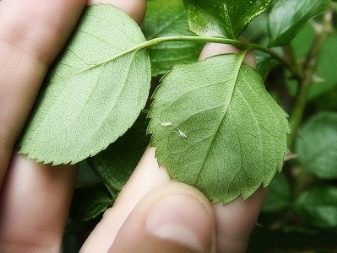
Useful Tips
The following guidelines are useful for those who grow roses at home or in the garden and want to prevent curling of the foliage.
- Indoor roses will definitely require drainage. If it is not there, moisture can begin to stagnate. This will lead to diseases that can cause the foliage to curl.
- Roses are watered only with warm water with weathered chlorine. When watering with cold liquid, the bush gets stress. Because of this, it stops growth, rolls up the leaves and sheds them.
- Horticultural crops must be loosened.This allows them to get a lot of oxygen and better resist disease. Homemade roses can also be loosened from time to time. An ordinary plug is enough for this. Without loosening, moisture passes worse to the roots, the plant begins to experience a lack of it.
- The soil near garden roses should be weeded. The presence of weeds should not be allowed, since pests are hidden in them, which very often become the first reason for curling the foliage of a street bush.
- Fertilization is incredibly important for roses. You cannot do without them, as they increase immunity. The first feeding is usually made nitrogenous. It is thanks to them that the foliage acquires splendor and a bright green color. When buds are formed, phosphorus and potassium are added. At the end of September, they stop feeding.
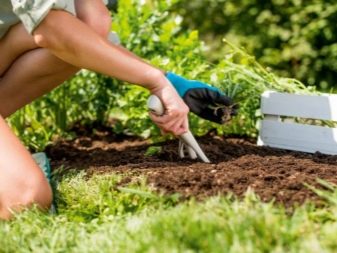
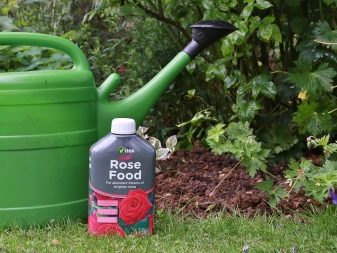

































































































The comment was sent successfully.